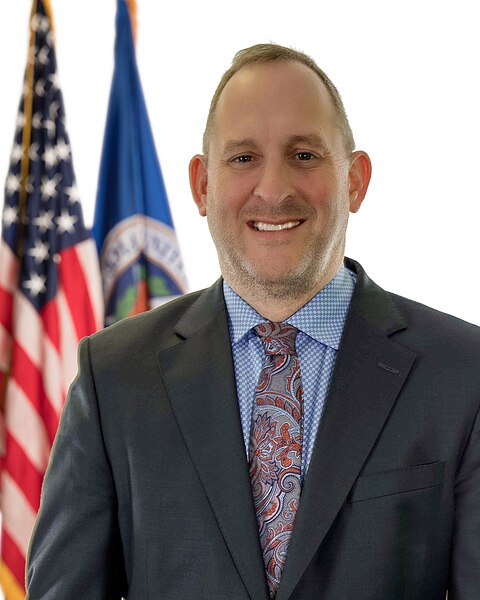OPM deputy defends administration's telework approach, touts ‘consensus-building’ in workforce policymaking

"There’s been a lot of engagement between the administration and the unions," OPM Deputy Director Rob Shriver said. Douglas Rissing / Getty Images
Rob Shriver argues the White House's calls to increase in-person work are consistent with the HR agency’s prior policies.
The federal government’s HR agency has been busy since President Biden took office.
The Office of Personnel Management has been a key player in a number of Biden administration initiatives, from establishing a minimum wage for federal workers and finding ways to boost compensation for historically underpaid professions such as federal wildland firefighters to helping other agencies with hiring surges following the enactment of the bipartisan infrastructure law and the Inflation Reduction Act.
The agency has also been hard at work devising and setting federal workforce policy, such as its guidance on telework and hybrid work environments, and proposed rules barring agencies from soliciting job applicants’ salary history in an effort to improve pay equity. The agency has another 31 proposed or final rules in the hopper, according to the spring 2023 unified regulatory agenda, a database of planned regulations maintained by the Office of Information and Regulatory Affairs, including regulations aimed at improving pay equity and entrenching federal employees’ civil service protections.

Source: OPM
OPM Deputy Director Rob Shriver told Government Executive last week that he believes the personnel agency's high productivity of late is attributable to a combination of two documents published early in Biden’s term: the president’s executive order aimed at protecting the federal workforce, which rescinded the bulk of Trump-era labor policy and aspired for the government to be a “model employer,” and the National Academy of Public Administration’s report recommending that OPM transform from a transactional agency focused on compliance into a government-wide leader in human capital management.
“Honestly, I think about the NAPA report a lot, and it’s baked into our strategic plan at OPM, and you’re absolutely right that across OPM as an organization, we take those recommendations seriously,” he said. “Compliance continues to be important, but there’s so much more that we can do . . . So coming into this job, we got that report I think in April of 2021, and then Executive Order 14003 was issued on Day 3 of the Biden administration. So that EO, that report, and those two things together really framed up what the OPM approach was going to be to labor relations in this administration.”
Officials with federal employee unions and Shriver have been open about OPM’s newly proactive stance to labor issues, frequently serving as an informal mediator to defuse conflicts between labor and management at federal agencies. That work has paid dividends on the policy side as well—Shriver said the administration’s openness with labor groups has made it easier to build consensus around initiatives.
“I think the throughline is really strong alignment between the Biden administration’s goals and union’s goals for federal workers,” he said. “There’s been a lot of engagement between the administration and the unions. We had a very nice framework coming in at the beginning of the administration for that engagement through the Safer Federal Workforce task force . . . One of the key principles there, to the extent that we were able, was that we would share information with agency officials about the latest in what’s been going on with COVID, and then we’d bring the unions together and have the same experts share the same information with them.”
OPM is now replicating that model of open communication and transparency both with agency management and union officials on other boards in which labor and management have a voice, such as the Federal Prevailing Rate Advisory Committee, a panel of federal officials and union stakeholders focused on calculating pay for federal workers in the mostly blue-collar Federal Wage System.
“One example: there’s this body, the Federal Prevailing Rate Advisory Committee, and it’s set up to look at the blue collar wage system,” Shriver said. “And for the first time ever, there was total consensus among unions and agency representatives on a major policy intervention to ask Congress to no longer cap the pay raise in the Federal Wage System.”
Another focus for OPM early in the Biden administration had been on expanding workplace flexibilities like telework and remote work. Although some feds have perceived recent efforts by White House Chief of Staff Jeff Zients and Office of Management and Budget Director Shalanda Young to “increase meaningful in-person work” at federal agencies this fall as inconsistent with the administration's overall approach to telework, Shriver defended both his agency’s and the White House’s mandates as consistent with one another.
“From my perspective, the discussion starts when the pandemic hit—with no notice, get everyone out of their offices and onto maximum telework to save lives—that was goal No. 1, and then we worked all through the pandemic and came to the period we called ‘reentry,’ ” he said. “That was all kicked off by the memo that OMB and [the General Services Administration] signed in May 2022 . . . That memo always envisioned a continuing evaluation of work arrangements, treating remote work as pilot programs and evaluate them, and then agencies would evolve as things continued to evolve.”
In short, Shriver said that OMB and the White House’s edicts last spring served more as a reminder to agencies to do their jobs to evaluate telework, rather than a deviation from the strategies outlined last year.
“There was some inconsistency in the extent to which agencies were doing that [evaluation] work, so OMB’s memo came out in the spring on organizational health and performance,” he said. “The way I read it was, ‘Hey, remember we’d reenter and keep thinking and evaluating? We want to make sure you’re doing it, and here’s a framework.’ And one of the conclusions I think we came to is that there is value in in-person work, and in order for that to be valuable and meaningful, it doesn’t work to be in there by yourself and still doing Zoom calls. You actually need a cohort of people you’re collaborating with.”




